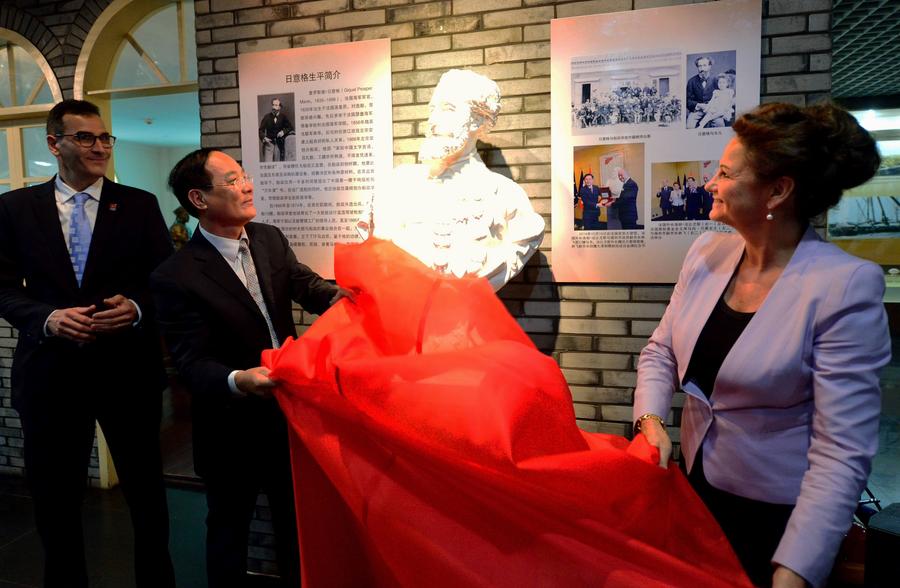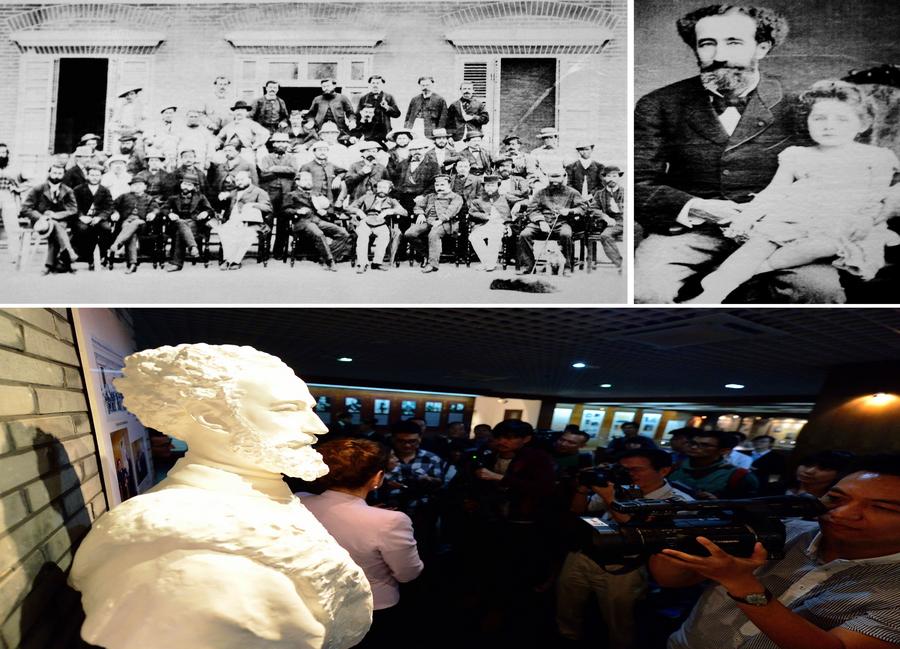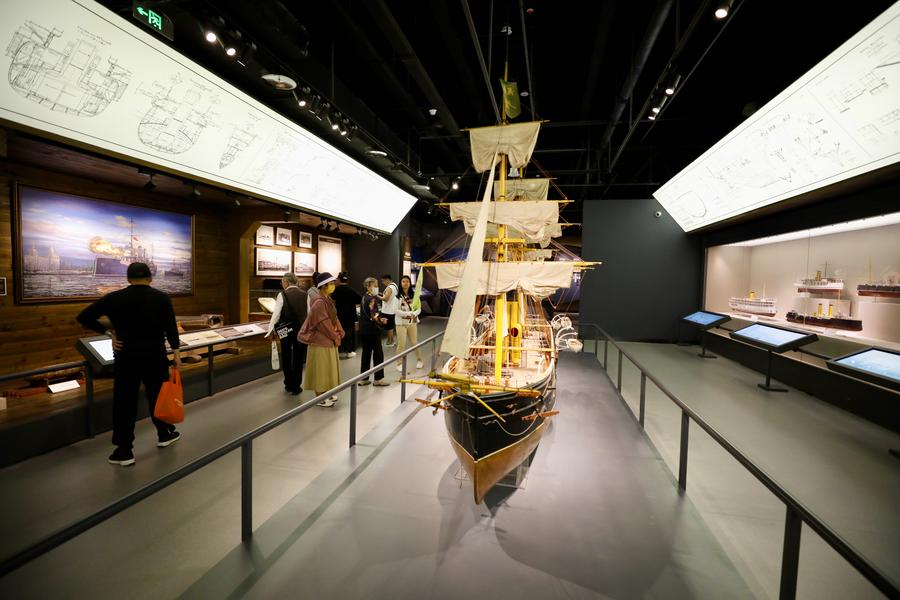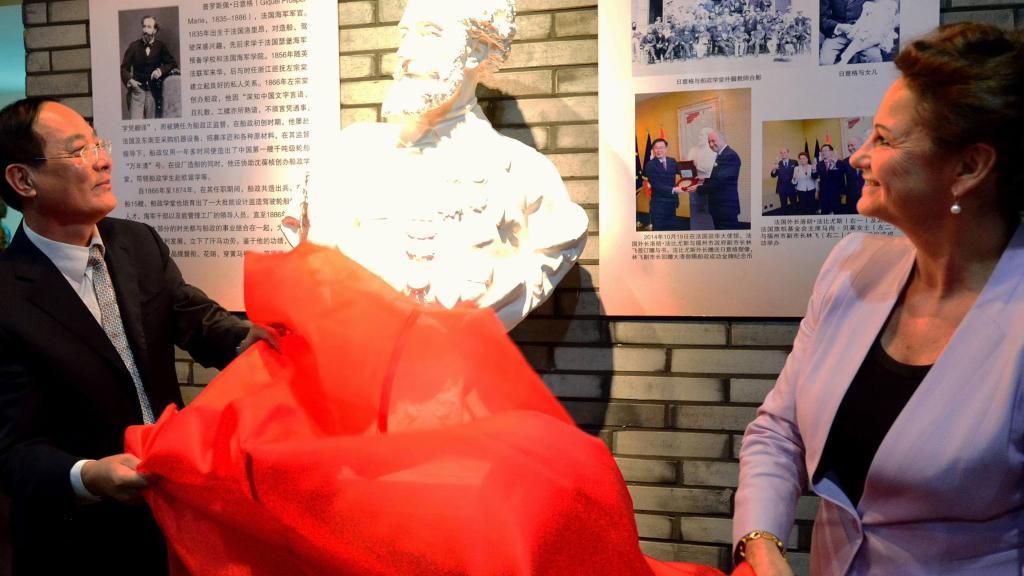
The statue of Prosper Marie Giquel was installed in the Museum of Foochow Arsenal 1866 in Fuzhou, east China's Fujian Province, Oct. 23, 2014. (Xinhua/Wei Peiquan)
FUZHOU, May 6 (Xinhua) -- Located on the bank of the Majiang River in east China's Fuzhou, capital of Fujian Province, is the precious industrial and cultural heritage site known as the Foochow Arsenal, which stands as a witness to China's Self-Strengthening Movement and a memorable chapter in the country's modernization journey.
Within the Museum of Foochow Arsenal 1866, the statue of a foreigner stands out. That is Prosper Marie Giquel, a Frenchman who is still remembered for his contribution to China's modern shipbuilding history.
The statue was gifted to the Fuzhou municipal government by the French Embassy in China in 2014 on the occasion of the 50th anniversary of the establishment of Sino-French diplomatic relations, in memory of a significant contributor to the history of Sino-French cooperation.
Born in 1835, Giquel arrived in China in 1857 as an officer of the French navy. At that time, China was facing both internal and external challenges, requiring the urgent reinforcement of its maritime defense capabilities.
Zuo Zongtang, better known as General Tso, then viceroy of Fujian and Zhejiang in what was the Qing Dynasty (1644-1911), noticed Giquel and asked him to facilitate cooperation between China and France, with the aim of assisting the Qing government in establishing a naval arsenal.
In 1866, the naval arsenal was established in what is today the Mawei District of Fuzhou. Giquel was appointed superintendent of this arsenal.
From then until 1874, Giquel served in this role with the arsenal, overseeing the manufacturing of 15 warships and merchant vessels, including China's first 1,000-tonne steam-powered warship, the Wannianqing.
"The naval arsenal broke through many technological barriers thanks to Giquel's connections, bringing Western military and industrial technologies from Europe to Mawei," said Chen Yue, president of the Mawei shipyard culture research association.
At that time, cultural exchanges and mutual learning between China and France extended beyond technology, exerting important influence on China's politics, military, education, science, technology, diplomacy and culture.

The statue of Prosper Marie Giquel was installed in the Museum of Foochow Arsenal 1866 in Fuzhou, east China's Fujian Province, Oct. 23, 2014. (Xinhua/Wei Peiquan)
Founded simultaneously with the shipyard was the first naval school in modern China, the naval school at the Foochow Arsenal. Lin Yingyao, an expert on the Foochow Arsenal, noted that Giquel's records, as documented, extensively described the operation of the naval school.
"Giquel provided detailed guidance concerning the curriculum, subjects, teaching and learning processes, student assessments, and evaluations of academic performance and capabilities," Lin said, adding that the naval school also employed instructors from France and Britain, who actively contributed to the training of modern talent for China.
In 1877, the school sent its first batch of students to France and Britain for further study, with Giquel serving as the foreign supervisor for these students.
"These students who studied in France explored the path of utilizing technology to save the country, while also realizing that Chinese culture could not remain stagnant and needed to integrate with the rest of the world. They were a group of elite forces in the industrialization of modern China," Chen said.
The tale of Giquel was revived in the 1980s, a hundred years after he passed away in Cannes, France, in 1886.
French scholar René Viénet learned about the naval school through Giquel's records, uncovering a segment of the history of the Foochow Arsenal long forgotten in France.
Curious about both this naval school on the other side of the ocean and why a Frenchman chose to teach in China a hundred years earlier, Viénet began his study of the traces of the Foochow Arsenal in France, and completed the collation of Giquel's diary.
In 2006, Viénet fulfilled his wish to visit Fuzhou, being profoundly impressed by the century-old shipyard in Mawei.
Ten years later, the exhibition "A Frenchman's Chinese Dream" was hosted in the former naval school, showcasing the materials collected by the scholar worldwide in the course of 10 years of research. He hoped to narrate the story of a brilliant and visionary young Frenchman who devoted his life to his dreams and career in China in the 19th century.

People visit the Museum of Foochow Arsenal 1866 in Fuzhou, east China's Fujian Province, May 16, 2023. (Xinhua/Jiang Kehong)
For nearly 20 years, he has paid many visits to the former sites of the Foochow Arsenal in China. Viénet and Giquel's descendants together planned an exhibition hosted in Lorient, Giquel's hometown in France, on the occasion of the 60th anniversary of the establishment of diplomatic relations between China and France, to tell the story of Giquel's life and his connection with a Chinese shipyard to the French people.
Now in his 80s, Viénet continues Giquel's "Chinese Dream," tirelessly promoting further communications and cooperation between China and France.
"The heritage of the Foochow Arsenal is evidence of the exchange of Chinese and French civilizations and a historical link in exchanges between the two countries," said Liu Jiangyuan, director of the management committee of Fujian shipyard culture. "We hope that through exhibitions and more exchanges and mutual learning, the story of the shipyard will be known to more people," Liu added.




 A single purchase
A single purchase









